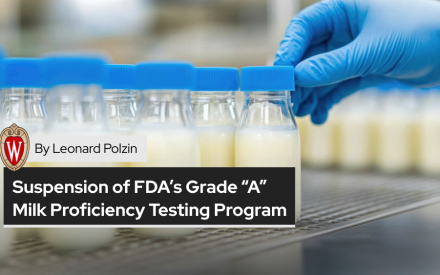Federal Milk Marketing Orders play a vital role in shaping the dairy industry, and the mechanisms through which these orders are amended and refined are governed by a complex framework of administrative actions. This article delves into the intricacies of Administrative Action Governing Federal Order Hearings, a process rooted in 5 U.S.C. 556 and 5 U.S.C. 557, and Ex Parte Communication. The foundation for these hearings is established by the Agricultural Marketing Agreement Act of 1937, particularly its 7 U.S.C. 601-674 Amendment, and guided by the comprehensive regulations outlined in 7 CFR part 900. These elements collectively form the backbone of a system designed to ensure fairness and adherence to established policies within the dairy industry.
Moreover, we explore the significance of the U.S. Code, particularly 5 U.S.C. 556 and 5 U.S.C. 557, in defining the procedures and standards that govern these critical administrative processes. By shedding light on these regulations, this article aims to provide additional understanding of the framework that underpins ongoing Federal Order hearings that are happening in response to industry proposals.
Administrative Action Governing Federal Order Hearings
Federal Order Hearings are how changes are made to Federal Milk Marketing Orders. The rules followed during these hearings are called administrative actions. The notice for hearings on proposed changes to marketing agreements and orders lays out the rules for the hearing process. The notice says:
“This administrative action is governed by the provisions of 5 U.S.C. 556 and 557 and, therefore, is excluded from the requirements of Executive Order 12866.
The hearing is called pursuant to the provisions of the Agricultural Marketing Agreement Act of 1937, as amended (7 U.S.C. 601–674) (Act), and the applicable rules of practice and procedure governing amendments to marketing agreements and marketing orders (7 CFR part 900).
Understanding the U.S. Code: Guiding Principles in the Federal Statutory Law and Administrative Hearings
In the law of the United States, the Code of Laws of the United States of America (U.S.C.) is the official compilation of federal statutes. The governing provisions of this administrative action determine how the hearing will be conducted as well as determine its breadth. Elaboration on these codes can provide the contextual significance they lend to the proceedings.
5 U.S.C 556, titled ‘Hearings; presiding employees; powers and duties; burden of proof; evidence; record as basis of decision’ is a provision in the Administrative Procedure Act (APA) that outlines the procedures for federal administrative hearings. The provision requires that the hearing be conducted by an impartial hearing officer and presided over by an administrative law judge. The parties involved have the opportunity to present evidence and cross-examine witnesses. The hearing officer must issue a written decision based on the evidence presented at the hearing.
Presiding federal employees have the authority to:
- Make decisions on offers of proof and accept relevant evidence.
- Conduct or permit depositions.
- Regulate the course of the hearing.
- Address procedural requests and similar matters.
This rule states that the responsibility to prove the merit of a proposed change in the FMMO system lies with the organization making the proposal. They need to present factual evidence to support their case. The agency can review both spoken and written evidence but needs to have a policy to exclude irrelevant or repetitive information. To make a change, they must look at the entire record or specific parts referenced by a party, and this evidence should be reliable, meaningful, and substantial.
Parties have the right to present their case using spoken or written evidence, offer rebuttal, and cross-examine for comprehensive fact disclosure.The transcript of testimony, exhibits, and all filed documents constitute the sole decision record, available to parties.
5 U.S.C. 557, titled ‘Initial decisions; conclusiveness; review by agency; submissions by parties; contents of decisions; record’, is another provision in the Administrative Procedure Act (APA). The first half of this section of code outlines procedures if a government agency is not directly involved in hearing procedures. In the case of recent FMMO hearings, USDA is playing an active role.
Ex Parte Communication: Understanding one-sided legal discussions and their implications
The second half of this section discusses ex parte communication. Ex parte communication refers to communication about a legal case or proceeding that involves only one party or side. It occurs when one party communicates with a judge, decision-maker, or other relevant individual involved in the case without the knowledge or participation of the opposing party. Ex parte communications can involve discussions, presentations, or the sharing of information that can influence the decision-making process without giving the other party an opportunity to respond or counter the information presented.
Ex parte communications are generally discouraged or restricted in legal proceedings to ensure fairness, transparency, and equal participation for all parties involved. This helps prevent one party from gaining an unfair advantage by presenting information or arguments that the other party isn’t aware of or able to address. In many legal contexts, there are rules and guidelines in place to govern and limit ex parte communications to maintain the integrity of the decision-making process. This provision is why any USDA employee or those they have employed under a short-term contract for the purposes of assisting with the hearing, have not been able to provide commentary on the proposal or the process.
If a prohibited communication occurs, the involved agency member or employee must place on the public record:
- All written communications.
- Memos detailing the content of oral communications.
- All written responses and memos detailing the content of oral responses related to the above communications.
Executive order 12866 outlines regulatory planning and review processes for significant regulatory actions undertaken by federal agencies. While most administrative actions are subject to its provisions, there are specific cases where an administrative action governed by 5 U.S.C. 556 and 557 might be excluded from the requirements of Executive Order 12866.
For the hearing, administrative action governed by 5 U.S.C. 556 and 557 is excluded from the requirements of Executive Order 12866 because the procedural adjudicatory proceeding does not establish new regulations or policies with significant regulatory impact. This exclusion recognizes that certain actions are more about ensuring fairness and resolving individual disputes than about shaping broader regulatory policy.
Administrative action governed by 5 U.S.C. 556 and 557 is excluded from the requirements of Executive Order 12866 for FMMO federal order hearings for the following reasons:
- Nature of the Action: Executive Order 12866 applies to regulatory actions that are intended to affect the rights, obligations, or benefits of parties outside the federal government. If the administrative action is purely adjudicatory and is not intended to establish a new regulation, policy, or standard, it might be excluded from the executive order’s requirements.
- Procedural vs. Substantive Matters: The provisions of 5 U.S.C. 556 and 557 primarily address procedural matters related to hearings, evidence, and decision-making. They don’t necessarily address substantive policy changes that could have broader economic or social impacts, which are the focus of Executive Order 12866.
- Narrow Scope: Adjudicatory proceedings under 5 U.S.C. 556 and 557 typically have a narrow scope and are specific to individual cases or disputes. In contrast, Executive Order 12866 is concerned with significant regulatory actions that can have broader implications for the public, the economy, or various industries.
- Focus on Fairness: 5 U.S.C. 556 and 557 are more concerned with ensuring procedural fairness and due process for parties involved in the adjudicatory process, rather than addressing potential regulatory impacts on a larger scale.
Legal Framework: Agricultural Marketing Agreement Act of 1937 and regulations for agricultural marketing agreements and orders
Agricultural Marketing Agreement Act of 1937 as amended by (7 U.S.C. 601-674, Declaration of Conditions ) authorizes the Secretary of Agriculture to enter into marketing agreements with processors, producers, and other handlers of agricultural commodities. The Act also establishes rules of practice and procedure governing amendments to marketing agreements and marketing orders.The rules of practice and procedure governing amendments to marketing agreements and marketing orders under the Agricultural Marketing Agreement Act of 1937 can be found in the Code of Federal Regulations (CFR) Title 7, Chapter IX, Part 900. The general regulations in Part 900 of the CFR cover various aspects of the formulation, amendment, and termination of marketing agreements and orders. Some key elements of these regulations include:
- Notice of hearings: The Secretary of Agriculture must provide due notice and an opportunity for a hearing on a proposed order or amendment.
- Issuance of orders: After the hearing, the Secretary of Agriculture must issue an order if they find that the order and its terms and conditions will tend to effectuate the declared policy of the Agricultural Marketing Agreement Act of 1937.
- Amendments: The Secretary of Agriculture may amend any marketing agreement or order if they find that the amendment will tend to effectuate the declared policy of the Act.
- Termination: The Secretary of Agriculture may terminate or suspend the operation of any order or agreement if they find that the order or agreement no longer tends to effectuate the declared policy of the Act.
7 U.S.C. 601-674 Amendment, known as “The Amendment,” is part of the United States Code that outlines policies and provisions related to agricultural commodity programs. It plays a crucial role in shaping agricultural policy and influencing agricultural trade and exports. The Amendment’s importance stems from its impact on the agricultural sector and its role in shaping the legal and regulatory framework for U.S. agricultural programs.
7 CFR part 900 Agricultural Marketing Service, Department of Agriculture, General Provisions contains general regulations for federal milk marketing orders. These sections of regulations outline procedural requirements for various aspects of marketing agreements and orders, including proceedings, amendments, arbitration, and referenda. They also cover definitions, investigations, penalties, public information, information collection, and exemptions from assessments, providing a comprehensive framework for managing and governing these activities in the agricultural sector.
The Agricultural Marketing Service (AMS) is committed to complying with the E-Government Act. The Act provides that administrative proceedings must be exhausted before parties may file suit in court. Under sec. 8c(15)(A) of the Act, any handler subject to an order may request modification or exemption from such order by filing with the U.S. Department of Agriculture (USDA) a petition stating that the order is not in accordance with the law. The Act provides that the United States District Court has jurisdiction to review USDA’s ruling on the petition.


 Dairy Market Dynamics and Domestic Constraints: A Dairy Sector Assessment as of June 2025
Dairy Market Dynamics and Domestic Constraints: A Dairy Sector Assessment as of June 2025 U.S.–Canada Dairy Trade Relationship (2025–Present)
U.S.–Canada Dairy Trade Relationship (2025–Present) Suspension of FDA’s Grade “A” Milk Proficiency Testing Program – A Comprehensive Analysis
Suspension of FDA’s Grade “A” Milk Proficiency Testing Program – A Comprehensive Analysis Policies and Regulations Governing Milk and Dairy Testing: A Wisconsin Overview
Policies and Regulations Governing Milk and Dairy Testing: A Wisconsin Overview


